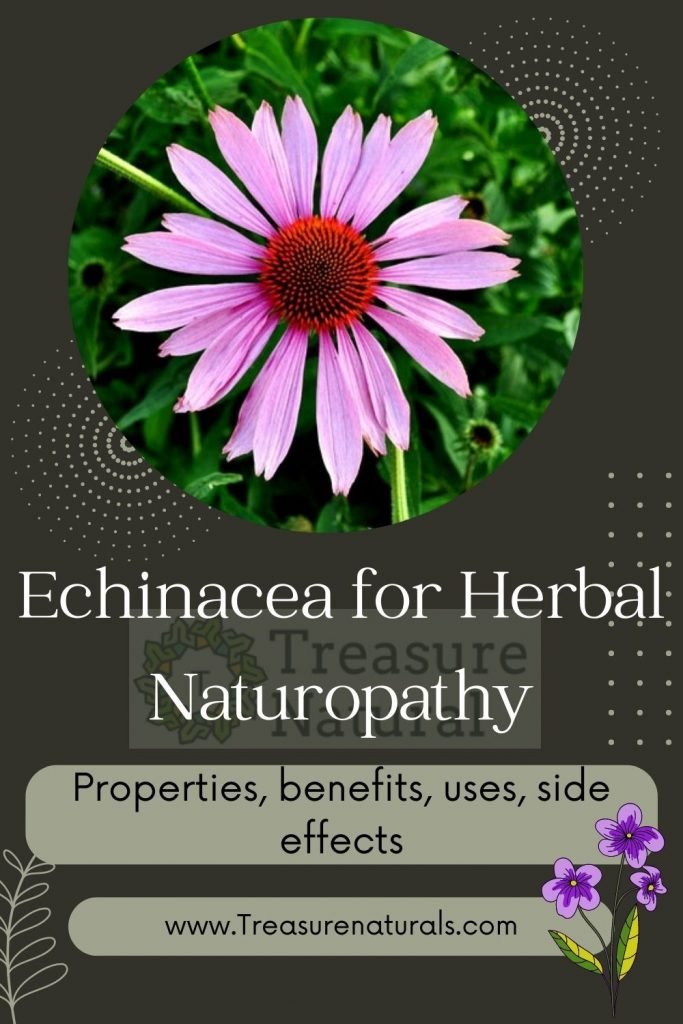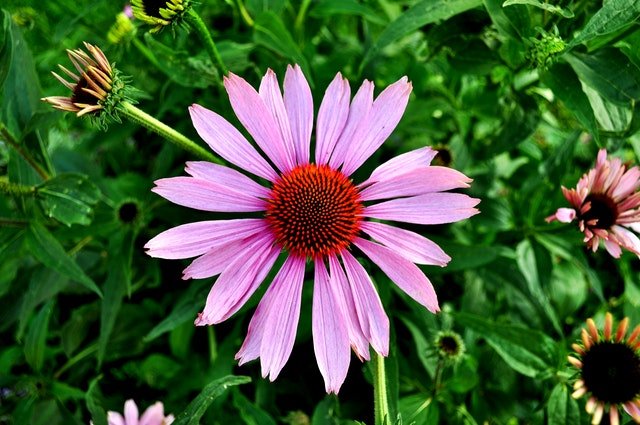
Echinacea is an immunostimulating plant and is one of the most used natural remedies to increase the immune system.
Echinacea (Echinacea purpurea, Echinacea angustifolia and Echinacea pallida) belongs to the Compositae or Asteraceae family.
Known for its immunostimulating and immunomodulating properties, it is useful for promoting immune defenses in order to prevent and treat the symptoms of cooling diseases.
What Echinacea is and what is it used for
Echinacea is a large perennial herbaceous plant that can exceed one and a half meters in height. Endowed with a cylindrical rhizome and slightly reddish stems, the echinacea plant has leaves gathered in a basal rosette, oval or lanceolate and whole.
From the leaves in spring develops a stem that carries large flower heads formed by dark central tubular flowers surrounded by pink ligulate flowers, of more or less intense color depending on the variety.
Echinacea is native to North America, Mexico, Louisiana, Florida. In Italy it is cultivated both for medicinal purposes and for its ornamental value.
In herbal medicine, the roots of echinacea pallida, purpurea and angustifolia and the aerial parts of the purple variety are used for their properties:
- Immunostimulants;
- anti-inflammatory;
- vulnerary (healing).
Echinacea is therefore used to prevent colds, relieve flu symptoms, counteract relapsing infections (for example cystitis or vagienal candida) and, for topical use, to treat wounds, ulcers, sunburn, canker sores and dermatitis.
Always externally, echinacea is useful for improving the appearance of mature and dry skin.
Uses of Echinacea
Of echinacea, the root in decoction, the squeezed aerial parts (echinacea juice) or in infusion, the mother tincture and the dry extract are used.
On the market there are also several echinacea supplements, in capsules or tablets in which echinacea extract can be associated with other plants with immunomodulating and adaptogenic action such as eleutherococcus.
Also popular are echinacea products for children, including syrups, formulated to relieve sore throats and other flu symptoms. Echinacea is then available in pharmacies as a homeopathic remedy.
Echinacea can also be included in the formulation of creams and ointments to be used externally for its therapeutic or cosmetic properties. Echinacea juice can also be used to treat wounds and eczema.
Recommended dosage
- Mother tincture of echinacea: 60 drops per day diluted in a little water, three times a day.
- Echinacea juice: 6-9 ml per day.
- Decoction of echinacea: 1 gr of echinacea root for each cup of water, to be boiled for about 10 minutes. Up to three cups a day are consumed.
- Echinacea infusion: one gram of aerial parts of echinacea for each cup of water. You can consume several cups a day.
- Echinacea supplement: the dosage is 900 mg of the drug per day, divided into three administrations.
Preventive treatments with echinacea should not exceed eight weeks and may possibly be resumed after a one-month break.
As for the side effects of echinacea, the use of this remedy is considered safe.
However, echinacea should not be used in case of
- Allergies;
- autoimmune diseases;
- in patients on immunosuppressive therapy.
You should consult your doctor during pregnancy and lactation and if you are taking medications or other supplements.
Benefits of Echinacea

The intake of echinacea is able to activate the phagocytic action of macrophages, stimulate lymphocytes and increase the production of cytokines, strengthening the non-specific immune system, of adults and children.
Echinacea is also able to inhibit hyaluronidase and consequently the breakdown of hyaluronic acid polymers. In this way the viscosity of tissue fluids increases making it difficult for pathogens to enter the tissues.
The benefits of echinacea derive in part from the content of low, medium and high molecular weight polysaccharides, responsible for immunostimulating activity.
The plant also contains flavonoids (such as luteolin, kaempferol, quercetin, apigenin) with anti-inflammatory action, derivatives of caffeic acid (including echinacoside present in the root of Echinacea pallida, with antiviral activity), alkylatides and essential oil with antibacterial properties.
Regular intake in autumn and winter allows you to prevent and treat the symptoms of colds such as fever, infections of the respiratory system (colds, coughs).
Echinacea is also useful in the prevention of recurrent infections such as cystitis and vagienal candida.
For external
use Echinacea is used for the preparation of ointments and lotions for the skin with immunostimulating, protective, anti-inflammatory action to be used in case of scars, canker sores, ulcers, dermatitis.
The temporary inhibition of jaluronidase is ultimately responsible for the anti-wrinkle action of echinacea and justifies its cosmetic use.






